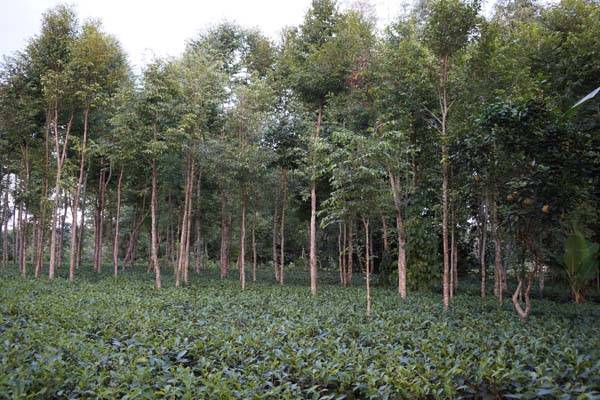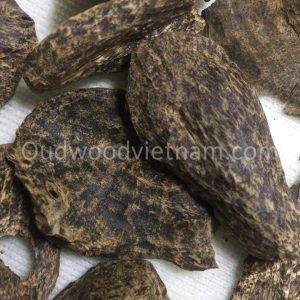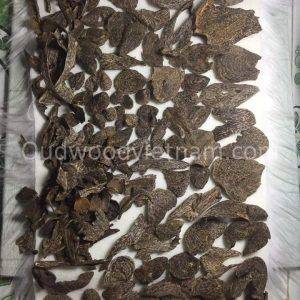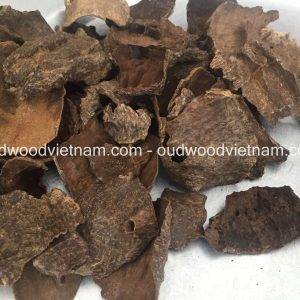Oud Agarwood
India is home to two Aquilaria species
The primary source of agarwood and one of the world’s most expensive trees, the evergreen agar tree (Aquilaria malaccensis Lam) is a step away from extinction in the wild.
Wild agarwood trees are battling extinction. The resin-filled wood from the tree is used in perfumery and high quality incense.
Scientists say the species has adapted to growing in petroleum oil-contaminated agricultural fields in Assam in India’s northeast, believed to be the cradle of agarwood aromatics. They are also widely grown in home gardens that indirectly aids in conservation.
Growers demand a policy on agarwood so that they can get the right price for the produce that is being exploited by traders who reap the maximum financial benefits from the trade.
The primary source of agarwood and one of the world’s most expensive trees, the evergreen agar tree (Aquilaria malaccensis Lam.) is a step away from extinction in the wild.
In Assam, reputed to be India’s agarwood capital, the adaptability of the critically endangered trees to oil-contaminated agricultural plots and its proliferation in home gardens, have raised hopes of conserving the embattled species, amid the absence of a policy to support agar cultivation and industry.
“Growth and adaptation of agar plants in polluted sites means this species has a capacity to tolerate the metallic and hydrocarbon pollution. So, plantation of agarwood in polluted sites is a profitable business for both conservation and restoration of degraded soil,” Hemen Sarma of the department of botany at N N Saikia College, Titabar, Assam, told Mongabay-India.
Agarwood or the resin-embedded wood of infected agar trees is a valued ingredient in high quality perfumery and incense. Rising demand, problems in monitoring harvests and a persistent illegal trade have imperilled the highly prized fragrant resinous wood-bearing trees through its range in northeast India and southeast Asia.
In a book chapter on “Agro-ecosystem diversity in petroleum and natural gas explored sites,” Sarma and co-authors underscored the importance of rural community in Assam harnessing polluted sites to cultivate agarwood, that is socio-economically and culturally integral to them.
“In Assam, rice and tea are major crops. Some of the agricultural lands, where these are cultivated, are situated near oil fields that have resulted in soil contamination in low/high degree. This contaminated agricultural land has become unfit for high production of sensitive crops like rice,” the chapter states, adding that Assam also accounts for 15 percent of India’s total crude oil output.
In response to this issue, Sarma said, members of the local community, especially small scale farmers, have focused on raising some other essential plants or trees such as Aquilaria spp., Areca catechu (arecanut) and Musa genus (banana) that can tolerate the contaminated soil.
Assam, the heart of the multi-crore agarwood trade in India, is known for the commercial production of premium quality agarwood (A. malaccensis Lam.), which is especially popular in Arab countries. More than 100,000 (one lakh) people are directly dependent on agarwood oil industry in the state, experts said.
Though they are not the direct producers of agarwood or oil, small growers sell their trees to distillers (the oil is extracted from the agarwood through distillation). These small growers usually let this plant flourish in their yards, field boundaries, as shade trees for tea plantations and even on the banks of ponds, Sarma explained.
These nurseries and home gardens created by rural communities for cultivating A. malaccensis to obtain resinous wood also reduce exploitation in natural forests.
“In Assam, homestead gardens are quite large in area and people are growing A. malaccensis extensively for their economic upliftment and indirectly protecting the species from the danger of extinction,” said Purabi Saikia of Central University of Jharkhand, India.
Saikia’s study in home gardens of Upper Assam found that agar plants contributes up to 20 percent of the total annual income of the family.
“The economic potential of agar is unusual compared to other home-garden products and acts as a compulsion factor to cultivate the species. The low input for management and growth, lack of site specificity and intercropping adaptation make agar a preferred cash crop,” Saikia told Mongabay-India.
The hunt for agarwood and innovations
In addition to Aquilaria plants, agarwood is also produced by some plants of the Gyrinops and other genera. India is home to two Aquilaria species, A. khasiana and A. malaccensis.
In use for over 2000 years for medicinal, aromatic and religious purposes, Aquilaria malaccensis is the preferred source of agarwood for perfumery and religious traditions in the Middle East and in India.
The fact that not all Aquilaria trees have agarwood is a key contributor to its decline. It is only when Aquilaria trees are bruised by external factors such as physical injury, insect attack or bacterial/fungal infection, that they form agarwood, in defence.
Formation of resinous agarwood from which perfume compounds are recovered is a rare event in nature that is complex and is poorly understood, said Mojibur Khan,of Institute of Advanced Study in Science and Technology (IASST), Assam.The resin is produced in an immune response to attack from fungi or injury. Growers say a borer insect called Zeuzera conferta Walker also plays an important role in triggering disease and formation of resin in agarwood.
“Naturally only about one percent of the plants produce resin. The rate of infection has now gone up due to artificial inoculation,” Khan said, adding his research into new approaches will reduce dependence on plants and will help in conservation.
“We are trying to address few important issues with agarwood by developing an in vitro agarwood oil production technique using tissue culture/cell culture and fungi as also genetic engineering (metabolic engineering) in cell culture for agarwood oil formation. We are also planning to develop superior plantlets for better resin formation,” Khan told Mongabay-India.
Northeast India is particularly significant for agarwood (called ‘sanchi’ in Assam).
The northeast of India (particularly Assam, Mizoram and Tripura) is considered to be the cradle of agarwood aromatics with ancient traditions of agarwood production which is thriving and growing. Tripura’s capital Agartala takes its name from plants, explained Khan. The bark of the tree was used as writing material to write religious scripts in Assam. “The climatic conditions of these areas favour the plantation of Aquilaria malacensis,” he said.
It is estimated that for the production of one litre of oil, about 100 to 150 kilos of agarwood is necessary. It is sold in the form of wood chips, wood pieces, powder, dust, oil, incense ingredients and perfume for several thousand U.S. dollars per kilogram.
Only trained eyes can make out infected trees from healthy ones. To hunt for agarwood-bearing trees, farmers often chop off healthy, non-agarwood bearing ones, explained Purabi Saikia.
“An Aquilaria tree has wood that is white, soft and without scented resins. Once the infection develops, it is located deep within the trunk and resin formation changes density of the affected wood and transforms it to a dark brown or black colour. So whole trees are felled indiscriminately,” Saikia said.
Large-scale logging operations have destroyed many forested areas where the Aquilaria trees were abundant, Khan chipped in.
To complicate matters, it takes at least a couple of decades for the formation and harvest of agarwood in the wild. Nowadays due to artificial induction of infection to reduce dependence on wild population, the duration has shrunk to five to ten years but the quality of oil may be inferior, said Sarma.
The rarity of the infection and demand outstripping supply led prices to skyrocket and over exploitation of Aquilaria trees in their natural habitat.
Trade monopoly in agarwood
Agarwood is a protected species under the Indian Forest Act, 1927, and is scheduled tree species under the Wildlife Protection Act, 1972. Latest IUCN estimates say “deforestation has led to an 80 percent population decline for the species over the past 150 years.”
Accounts of international trade in agarwood date back as early as the thirteenth century, note India being one of the earliest sources of agarwood for foreign markets.
Legal international trade in agarwood is regulated through a system of permits by the Convention on International Trade in Endangered Species of Wild Fauna and Flora (CITES), but illegal and/or unsustainable trade is placing a burden on continuing supplies of agarwood.
All Aquilaria species are listed in Appendix 2 of CITES and as a CITES signatory, India does not permit agarwood “harvest in the wild” but it does re-export agarwood products. Agarwood is mainly traded as wood, wood chips, powder and essential oil.
India’s Ministry of Environment, Forests and Climate Change (MoEFCC) published a draft policy in 2014 for sustainable utilisation of agarwood. However, it was strongly opposed by agar growers on the ground that it doesn’t favour them and agarwood cultivation. A fresh draft policy is in the works.
All Sanchi (Agar) Growers Association of Assam (ASGAA), who had submitted their demands to the ministry following the ministry’s request to hand in the growers’ suggestions to prepare a fresh policy, said small growers do not get proper price for their produce while illicit trade carries on benefiting the businessmen.
“The farmers never get the benefit from the Centre or the state because there is no policy in place and no funds allotted to developing agar cultivations. They do not know the value of the wood in international markets. For tea there is a tea board in India and we have demanded agarwood boards in every district like tea board as also a common export policy,” Bikash Borah, general secretary of ASGAA told Mongabay-India.
“In addition to conserving the agarwood plantations, we also want the policy to consider protecting the borer insect population. We support naturally infected zone and in the zones where there is no natural infection, artificial inoculation can be done. We have also stated this in the policy,” Borah.
Borah and individual growers Mongabay-India spoke to also iterated that certain sections of traders and bureaucrats have monopolised the industry by perpetrating the notion that harvest of agarwood is illegal in general.
“Harvest is illegal only if it is from the wild. Major chunk of agarwood comes from private plantations. So by spreading propaganda, traders procure agarwood from cultivators at a low price,” Borah said.
“Whenever you harvest (from private plantations), you can get the transit permit (TP) for export and you have to prove that this is from your own plantation. Before exporting you have to prove to international agencies that this is not illegal or this is not from forest,” Borah said.
“Exporting the oil is legal under certain conditions – you have to show source of the product, whether it is from forest or plantation,” he said.
But transit permits (TP) are being forged.
“Traders harvest trees from plantations in Upper Assam and they don’t collect TPs from forest department. They show TPs from other countries. From the grassroot level, the whole market is going on illegally. And government is not getting enough revenue,” Borah said.
Saket Badola, Head TRAFFIC India, believes that there are enough regulations in place but enforcement needs to be stricter.
A TRAFFIC report states: “Prior to the 1991 export ban on wood and wood products, Mumbai served as the main exporting centre to Middle Eastern countries. Agarwood harvested from north-east Indian states, predominantly Assam, was taken to Hojai in Assam where it was processed into chips, dust and oil.”
“Importers and exporters previously supplied traders in Mumbai and Kolkata, primarily with Assamese agarwood, but suppliers have largely shifted their base to south-east Asian countries, particularly Singapore, owing to the scarcity of Indian agarwood.”
About a decade ago, northeast India, mainly Assam, harboured an estimated nine to ten million Aquilaria trees in plantations. The numbers have increased since then even though the wild stock decimated, said an agarwood researcher from the region, on conditions of anonymity.
“In other agarwood growing countries, there is a fixed quota on how much agarwood can be exported. India and Myanmar so far have not fixed the quota. You need to have non-detriment findings (NDF) data that tells you how many agar trees are present and how many are in harvestable stage for facilitating transparent international trade from plantations,” the researcher said requesting anonymity.
Debajit Gogoi, an agarwood grower called for reviewing restrictions on plantation-grown agarwood trade. The irony is, as Gogoi pointed out, “there are not even 1000 trees in Assam in the wild but there are more than 10 million trees in Assam in plantations.”
Referring to the “Assam Vision Document 2016 to 2025”, framed by the incumbent Bharatiya Janata Party, Gogoi said none of the promises made on agarwood have been fulfilled.
The document talks about “agar business” in Assam being declared as industry. “The youth of Assam will be encouraged to take “agar business” and incentives will be provided accordingly, the document said.
It further said: “A separate branch of “agar cultivation” will be set up in forest department. Whoever is engaged in Agar export will have to obtain license from the government and a yearly assessment shall be submitted to the government in order to ensure accountability of the business.”
Gogoi said: “It is the basis of our economy. There are 70,000 to 80,000 agar growers and about 20,000 to 30,000 small businessmen. But it is not getting the attention it deserves from the government.”
by Sahana Ghosh on 18 October 2018







Oud Wood Agarwood Chips
Hoi An Oud Wood Agarwood Chips | Doi De A | Grade A++ | 20g
Oud Wood Agarwood Chips
Khanh Hoa Oud Wood Agarwood Chips | Chop Mu A | Grade A++ | 20g
Oud Wood Agarwood Chips
Natural Oud Wood Agarwood Chips | Mo | Grade A | 30g